John Belushi’s final days were a stark contrast to the vibrant energy that had defined his comedic career. When he checked into Chateau Marmont on February 28, 1982, he was a shadow of his former self, a 33-year-old man worn down by excess and struggling with personal demons. He requested his favored Bungalow No. 3, a discreet location near a private entrance, a preference shared by other members of the Saturday Night Live family who had been introduced to the hotel by Lorne Michaels. Chateau Marmont, for many in the entertainment industry, was a haven, a place where fortunes could rise and fall, much like Michaels’ own fluctuating career which he humorously linked to his room size within the hotel.
Belushi’s extended stay at Chateau Marmont that winter had been marked by instability. He had moved from suite to suite, seeking refuge from noise complaints – both his own and those of other guests. From the upper floors of Suite 69, he briefly occupied Penthouse No. 54, before finally settling into the bungalow. His wife, Judy, had visited and found the atmosphere unsettling, a quaalude discovered on the floor amplifying her concerns. Yet, Belushi persisted, surrounding himself with script drafts, research materials, and a new stereo, determined to create his next hit movie.
His ambition centered on Noble Rot, a romantic comedy set against the backdrop of California’s burgeoning wine industry. Days turned into weeks as he met with writers and executives, seeking feedback on the script. However, progress was slow, and neither his manager, Bernie Brillstein, nor Paramount Pictures were satisfied. The studio’s patience was waning. Michael Eisner, a Paramount executive, even proposed a drastic shift, pitching Belushi a comedic adaptation of The Joy of Sex, envisioning him in multiple roles embodying the spectrum of human sexuality.
It became increasingly evident to those around Belushi that he was deeply troubled. His focus was nonexistent, his days filled with cryptic phone calls, and his punctuality vanished. Meetings were missed, appointments ignored. His bungalow descended into disarray, mirroring his personal neglect. His speech became disjointed, his attire rumpled and unclean, and basic hygiene seemed forgotten. Filmmaker Al Reinert, encountering Belushi in the hotel garage, described a disoriented figure, “muttering incomprehensible curses, his pupils as black and dilated as wide-open camera lenses.”
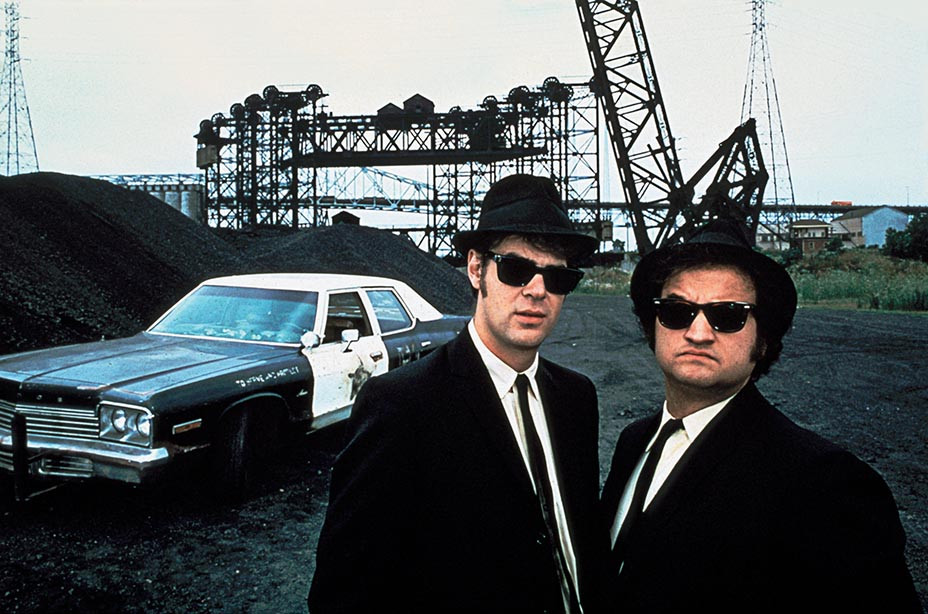 John Belushi in The Blues Brothers
John Belushi in The Blues Brothers
John Belushi’s iconic role in The Blues Brothers showcased his energetic and physical comedy style.
The pervasive suspicion of drug use was, tragically, accurate. Belushi’s appetite for excess was legendary – food, alcohol, and drugs were consumed with the same voraciousness he brought to his physical comedy. This hedonistic persona was part of his comedic appeal, both on and off screen. But this winter at Chateau Marmont, it was no act. He was immersed in a daily cycle of drinking, marijuana, and especially cocaine, escalating to heroin use, which he disingenuously claimed was “research” for a film about the punk rock scene.
In the permissive environment of early 1980s Hollywood, such behavior, while extreme, was often overlooked, particularly for those who generated substantial revenue for entertainment conglomerates. However, Belushi’s recent filmography was faltering. Continental Divide, Neighbors, and even Spielberg’s 1941 were box office failures. The Blues Brothers, while gaining a cult following, hadn’t recouped its inflated budget. His last major hit, Animal House, was almost four years prior—an eternity in Hollywood terms. His career was teetering, and his lifestyle choices were accelerating his downfall, a reality visible even to casual acquaintances. During a disjointed meeting at a Sunset Strip nightclub with studio executives and their wives, one of the wives poignantly likened Belushi’s state to Sunset Boulevard, Billy Wilder’s film about a faded star. Her husband initially dismissed the comparison, arguing Belushi was still famous. But she insisted, “Sunset Boulevard… We just saw it.”
Desperate Measures and Missed Opportunities to Save John Belushi
As John Belushi spiraled further into self-destruction within his Chateau Marmont bungalow, a circle of concerned individuals began plotting to bring him back to New York. His wife, Judy, and his close friend and collaborator, Dan Aykroyd, believed they could provide the support system he desperately needed to overcome his addiction and resume his creative work. Aykroyd, in particular, had a unique ability to draw out the best in Belushi. During a previous visit to the Chateau, their camaraderie was evident in a playful mock sword fight in the lobby lounge, using candlesticks as impromptu weapons. Aykroyd was actively developing Ghostbusters, a script intended as a starring vehicle for himself, Belushi, and fellow SNL alumnus Bill Murray.
However, simply reaching Belushi became an increasingly insurmountable challenge. His movements were erratic, shifting between nightclubs, private residences, restaurants, guitar shops, and bathhouses, often abandoning hired limousines to disappear with newfound acquaintances. When he was actually in his bungalow, he was frequently incapacitated, unable to answer calls or engage in coherent conversation, or else surrounded by a coterie of enablers and drug dealers, making meaningful intervention impossible. He was a man adrift, rapidly moving beyond the reach of those who genuinely wanted to help him.
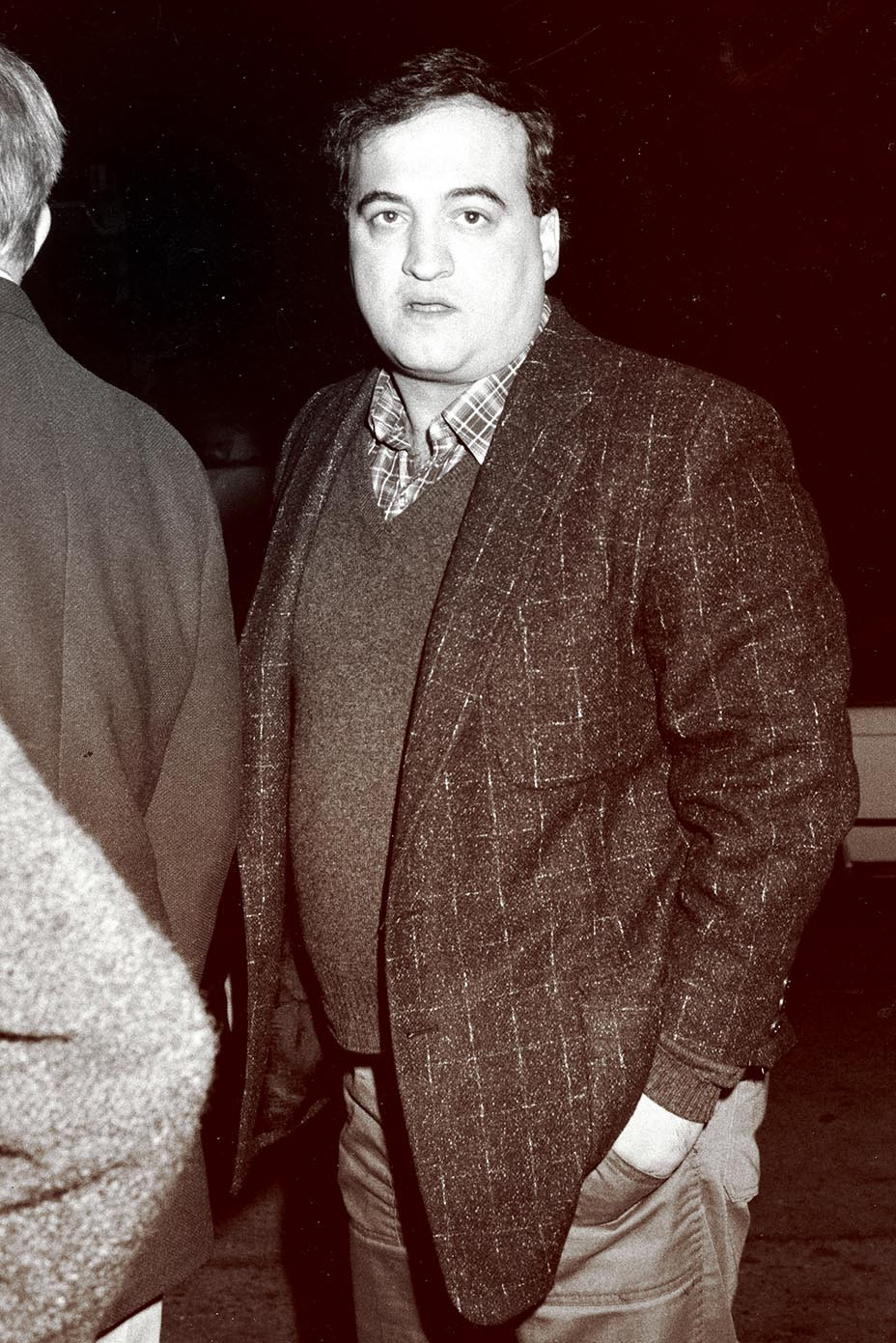 John Belushi and Danny DeVito at a wedding reception
John Belushi and Danny DeVito at a wedding reception
John Belushi and Danny DeVito, both known for their comedic talents, were part of the vibrant Hollywood scene of the era.
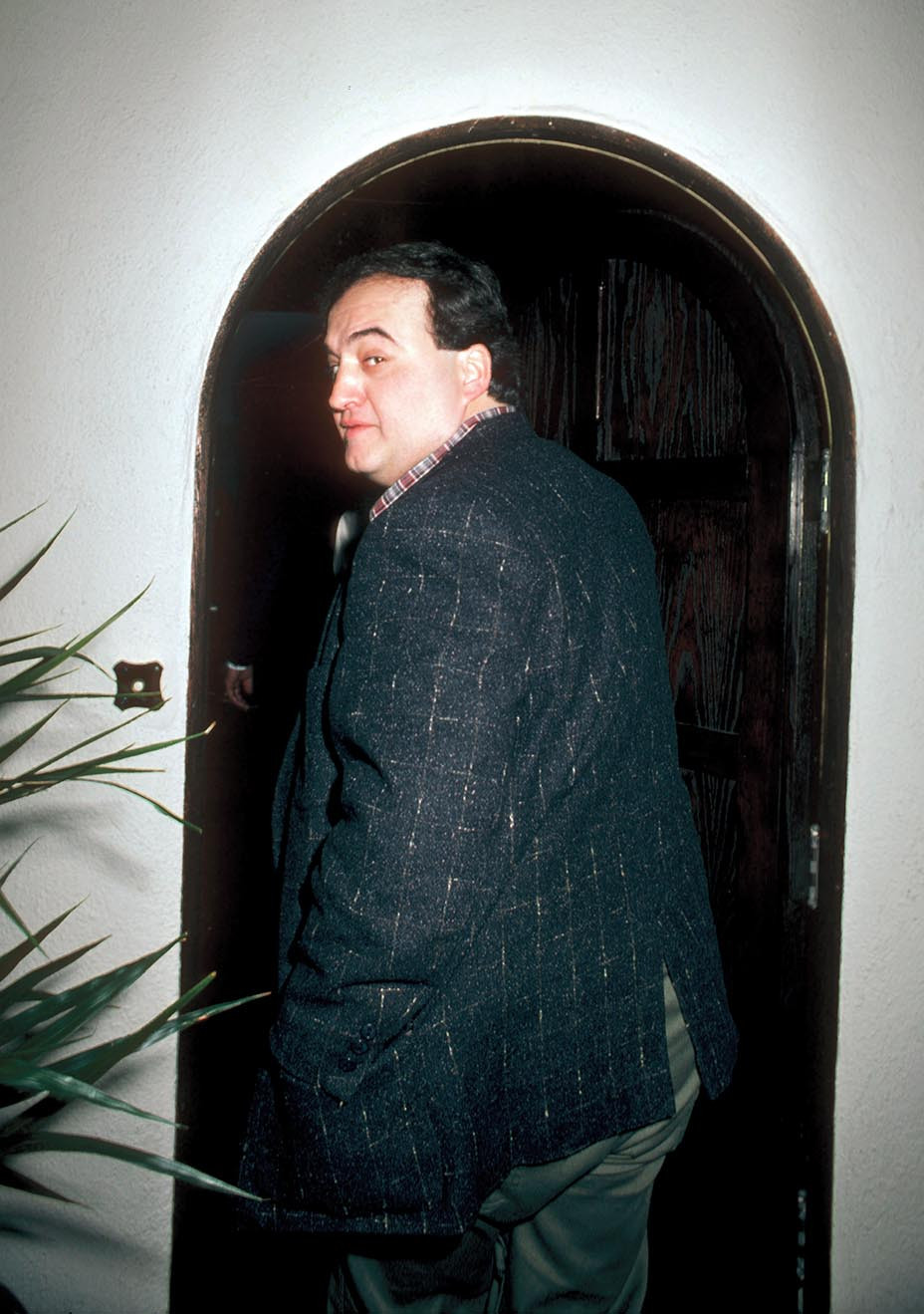 John Belushi at Danny DeVito and Rhea Perlman's wedding reception
John Belushi at Danny DeVito and Rhea Perlman's wedding reception
These images capture Belushi in a social setting, contrasting with the isolation and despair of his final days at Chateau Marmont.
Robert De Niro, also staying at Chateau Marmont while exploring film projects in Los Angeles, occasionally crossed paths with Belushi. Their connection stretched back to New York City’s lower Manhattan, where De Niro had been a guest at Belushi’s home, witnessing firsthand the wild parties in his basement rec room (one incident resulting in De Niro needing hospital stitches after a hand injury). De Niro had become a regular at Chateau Marmont, preferring its anonymity and service to rental homes after previous negative experiences in Hollywood. He maintained a penthouse suite, his laundry handled by the hotel, his car discreetly stored, finding a sense of familiarity akin to his New York apartment life.
During this particular stay, De Niro’s children visited. An afternoon party exposed them to Belushi’s alarming drug use – openly snorting cocaine and heroin to such excess that he had to excuse himself to vomit. This disturbing scene, however, didn’t deter De Niro, who was himself using cocaine at the time, from continuing to seek Belushi’s company after his children returned east. De Niro would visit Belushi’s bungalow for late-night gatherings, or they would spontaneously meet at Sunset Strip hotspots, embarking on further sprees.
On Thursday, March 4th, De Niro and actor Harry Dean Stanton spent the evening moving between Dan Tana’s, a celebrity-favored Italian restaurant, and On the Rox, a notorious nightclub known for its tolerance of illicit behavior. They repeatedly tried to reach Belushi, hoping to entice him to join them. When calls went unanswered, they drove to Chateau Marmont to personally invite him out. They found his bungalow in a state of devastation. The living room was not merely messy but trashed, indicative of a violent outburst. Adding to the unsettling scene was a woman named Cathy, described as “flinty” and “hard-eyed,” lounging amidst the squalor of pizza boxes, wine bottles, and dirty clothes, as if she had established residency and claimed ownership of Belushi. De Niro disliked her instantly, later calling her “trashy,” and was relieved to leave when Belushi suggested they return to On the Rox and revisit the bungalow later after the club closed.
De Niro departed, returning to Chateau Marmont in the early hours with Stanton and two women they had met. Back in his suite, he received a call from Robin Williams. Williams had encountered De Niro and Stanton at On the Rox, and they had agreed to meet up at Belushi’s after Williams’ impromptu comedy set at The Comedy Store. De Niro, already occupied, directed Williams to Belushi’s bungalow alone. Williams went and, like De Niro, was unnerved by the atmosphere, leaving quickly after brief conversation and a small amount of cocaine. Later, De Niro himself stopped by Belushi’s bungalow again, entering through the patio door. He exchanged a few words, took some of the cocaine openly available on the living room table, and returned to his suite. It was well past 3 a.m.
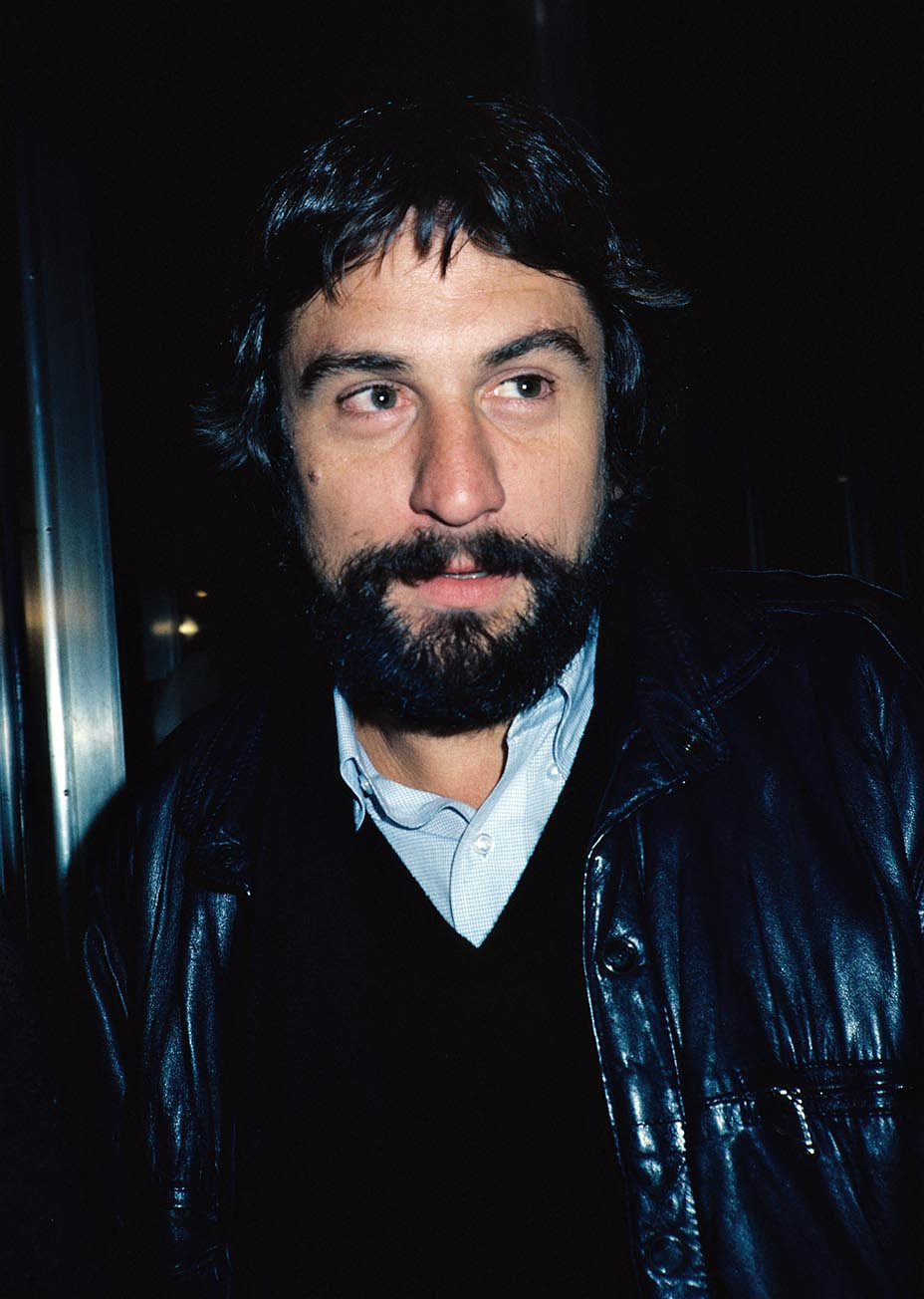 Robert De Niro in New York City, 1982
Robert De Niro in New York City, 1982
Robert De Niro, a contemporary of Belushi, was also present at Chateau Marmont during this period, and interacted with Belushi in his final days.
The Morning of John Belushi’s Death and the Immediate Aftermath
At 8 a.m. on March 5th, a room service waiter delivered breakfast to Belushi’s bungalow – wheat toast, jam, and coffee. Cathy Smith, the woman De Niro had found so distasteful, signed for the order, ate breakfast, tidied the room, notably removing drug paraphernalia, checked on Belushi who was audibly snoring in bed, and then left.
Shortly after, music producer and manager Derek Power mistakenly knocked on Belushi’s door, searching for Miles Copeland, manager of The Police, who was staying in another bungalow. Power knocked repeatedly, receiving no response before realizing his error and moving on.
Around noon, Bill Wallace, Belushi’s personal trainer and bodyguard, walked through the Chateau Marmont grounds, typewriter in hand. The day was bright and warm, and the few guests around the pool paid him little attention; creative individuals with instruments, equipment, and props were commonplace.
Approximately twenty minutes later, Joel Briskin, Bernie Brillstein’s assistant, arrived in a suit, moving quickly, again, attracting no particular notice.
But soon, paramedics arrived, followed by police officers, their presence signaling something serious. Within an hour, the area outside the hotel perimeter was buzzing with television news vans and paparazzi.
A sunbather, noticing the unusual activity, inquired at the lobby. A hotel employee, with classic Chateau Marmont understatement, described it as “There has been a slight disturbance.” The reality, however, was far more significant.
John Belushi had been found unconscious by Bill Wallace. Wallace attempted CPR but was unable to revive him. In Hollywood fashion, Wallace’s first call was to Brillstein, Belushi’s manager, whose office was nearby on Sunset Boulevard.
“I’m having trouble waking John up,” Wallace said, his voice strained. Brillstein, initially suspecting Belushi might be feigning sleep to avoid a Paramount meeting, said he would send someone over. Wallace called again, more urgently: “There’s something really wrong with John!” Brillstein instructed his secretary to call a doctor, who advised calling paramedics. She did, and Brillstein then dispatched Briskin to the hotel. Briskin was the man in the suit who had hurried past the pool.
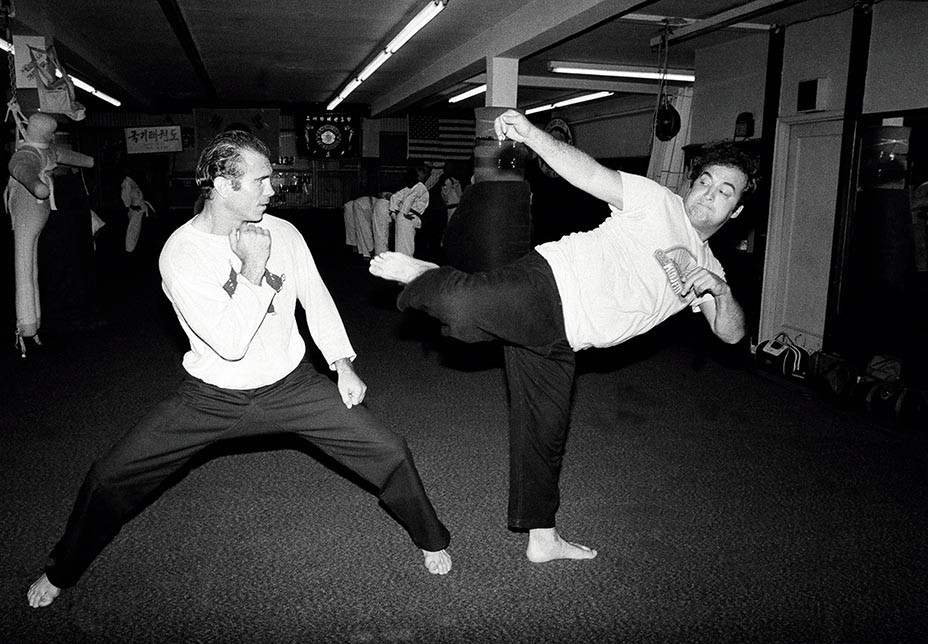 John Belushi with Bill Wallace
John Belushi with Bill Wallace
John Belushi’s fitness regime with Bill Wallace offers a glimpse into his efforts to maintain health amidst his chaotic lifestyle.
Briskin found Wallace in the bungalow, weeping and still attempting resuscitation. “Get out of here,” Wallace yelled. “John’s dead!” Almost immediately, paramedics arrived and confirmed Belushi’s death. Defibrillation was not even attempted; he was gone. They called the medical examiner, recognizing the needle marks on Belushi’s arms as indicators of a drug overdose.
Brillstein, meanwhile, had driven to Cedars-Sinai Medical Center, anticipating Belushi would be taken there. He alerted the hospital staff to expect a major star requiring immediate care and privacy. He waited anxiously for news. His thoughts raced – perhaps Belushi didn’t need the ER, maybe he was at another hospital, or, worst case, time was critical.
The call finally came from his office, delivering the devastating news.
He felt a physical reaction – sweat, hollowness, a shudder he described as “like a little stuttered giggle.” He hung up and composed himself, shifting into professional manager mode. He called Aykroyd, delivering the news directly, instructing him to go to Belushi’s house and inform Judy before the media broke the story. Then, he returned to his office to manage the unfolding tragedy, a catastrophe many had foreseen but felt powerless to prevent.
 Police outside Chateau Marmont after John Belushi's death
Police outside Chateau Marmont after John Belushi's death
Police presence at Chateau Marmont marked the beginning of the public and media frenzy surrounding John Belushi’s death.
Chateau Marmont Responds to a Tragedy
The Chateau Marmont staff was unprepared for the unprecedented situation. General Manager Suzanne Jierjian was away at a medical appointment when news of Belushi’s death reached the hotel. Upon her return, she was met with the chaotic scene of emergency vehicles and a growing influx of reporters and cameras. Her assistant, Tom Rafter, informed her of Belushi’s death, but details remained unclear. Ray Sarlot, co-owner of the hotel, arrived swiftly from a lunch in Beverly Hills, providing leadership amidst the bedlam. “It was bedlam,” he recalled, “swarming with outsiders, the switchboard was lit up.”
Among the frantic callers was Robert De Niro, who had been trying to contact Belushi all morning. Noticing the commotion from his suite, he called the front desk, only to be met with resistance. He insisted on speaking to Jierjian, who reluctantly took his call.
“Where’s John?” De Niro asked. “There is a problem,” she responded. “What?” “It’s bad.” “Is he sick?” “It’s really bad.”
De Niro understood. He dropped the phone, overcome with grief.
Sarlot took control, prioritizing cooperation with authorities while simultaneously aiming to control the media frenzy to protect other guests and the hotel’s reputation. Guards were stationed at entrances, directing traffic to the garage, the most manageable access point. Police established a barricade at Marmont Lane, restricting access to hotel guests and residents. A long-time guest noted, “It was the first time in all the years I’ve stayed there that I had to show my room key to get back into the hotel.”
Some media personnel breached security. One camera crew even reached De Niro’s suite, banging on his door live on television until he yelled “Go away!” Another reporter found a talkative gardener who confidently misreported Belushi’s cause of death as a heart attack, claiming his clothes were neatly folded, “as though he had gone to bed for the night… It looked like he choked on his tongue and the phlegm in his mouth.” (The gardener was subsequently reassigned to Sarlot’s home in the San Fernando Valley before returning to his regular duties).
Sarlot and his team successfully contained the situation, shielding other hotel guests from the unfolding drama. Sarlot later highlighted this discretion, noting, “What people don’t realize about the night Belushi died is that the whole time all of that stuff was going on, Tony Randall was living right next door! Tony had no idea what was happening until he saw the coroner’s wagon.”
Eventually, Belushi’s body was removed from the bungalow on a gurney and taken to a coroner’s vehicle on Monteel Road. The street was packed with media and onlookers. As reporters surged forward, Jierjian intervened, her firm demeanor silencing and pushing them back. A police lieutenant, impressed, asked if she would consider working for the LAPD, remarking, “We need somebody like you who can handle the press.”
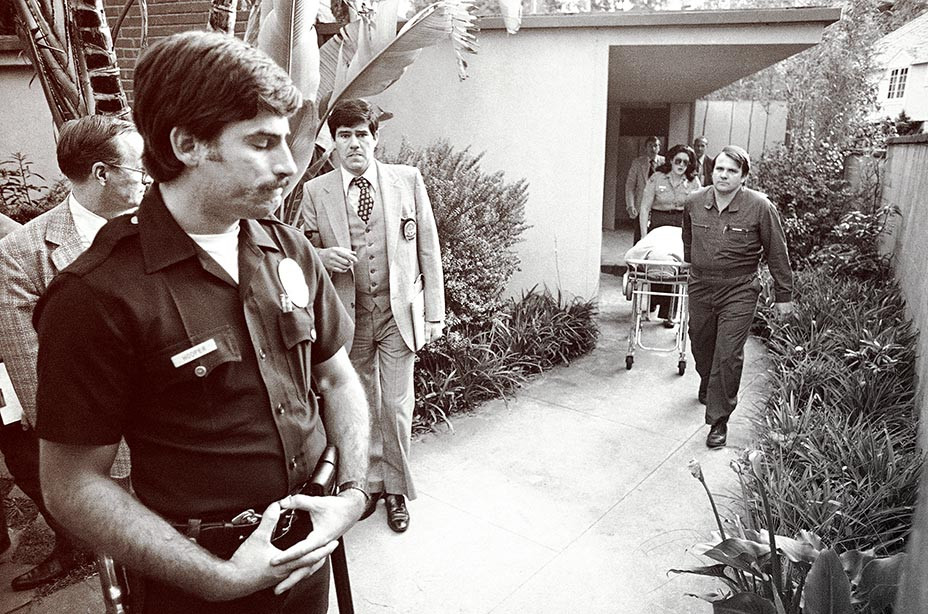 Officials removing John Belushi's body
Officials removing John Belushi's body
The somber removal of John Belushi’s body marked the end of his life and the beginning of the public examination of his death.
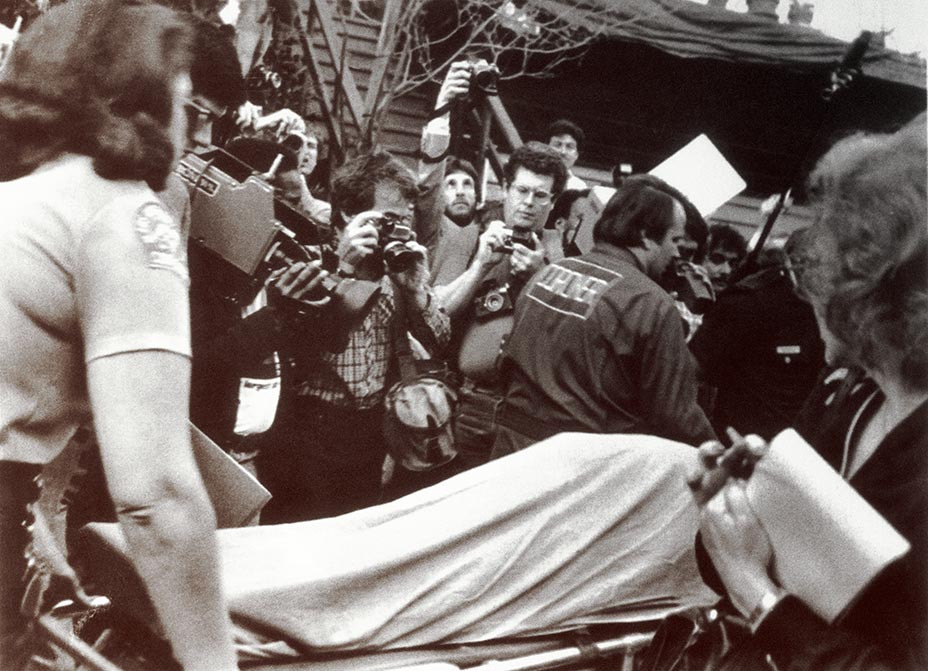 John Belushi's body being taken from Chateau Marmont
John Belushi's body being taken from Chateau Marmont
These images capture the gravity of the event and the intense media scrutiny surrounding John Belushi’s death at Chateau Marmont.
The Lingering Shadow of John Belushi’s Death
The day after John Belushi’s death, Brillstein and his assistant returned to Bungalow 3 to collect Belushi’s personal effects. Police had already conducted a thorough search, finding marijuana and traces of white powder, along with small paper envelopes associated with cocaine and heroin. Brillstein was shocked by the bungalow’s condition: “The scene was not only depressing, it was depraved. I couldn’t believe John had lived there.” Amidst the squalor of half-empty drinks, food waste, and scattered papers, Brillstein salvaged a few personal documents and a jacket to dress Belushi for his journey back east for burial.
Sarlot and his staff meticulously cleaned and remodeled the bungalow, replacing furniture and décor. “It was no longer the same unit,” Sarlot stated. “We didn’t want the place to become a cult symbol.” Enhanced security remained for a month to deter unwanted attention.
However, Chateau Marmont’s relationship with Hollywood notoriety was irrevocably altered. Once a discreet haven amidst the Hollywood bustle, Belushi’s death thrust it into the spotlight. A morbid form of tourism emerged in the 1980s, “ghoul tours” highlighting locations of scandalous Hollywood incidents. Chateau Marmont, specifically Bungalow 3, became a regular stop, guides pointing out the “naughty” hotel where John Belushi died. Curiosity seekers occasionally trespassed, hoping for a glimpse of the infamous bungalow, often disappointed by the hotel’s understated elegance. Even artist Jean-Michel Basquiat, arriving in Los Angeles soon after Belushi’s death, requested to stay in Bungalow 3, a chilling foreshadowing of his own overdose death in 1988.
In 1984, Bob Woodward, famed for his Watergate reporting, published Wired: The Short Life and Fast Times of John Belushi. This exhaustive, yet critically viewed, account detailed Belushi’s final years, relying on interviews with numerous intimates, including Judy Belushi, Jim Belushi, Dan Aykroyd, Bill Wallace, Bernie Brillstein, and Cathy Smith, who later pleaded no contest to involuntary manslaughter in Belushi’s death. Wired became a bestseller, but its bleak portrayal of addiction and Hollywood excess drew widespread criticism from those close to Belushi.
Brillstein felt Woodward approached the subject with a pre-conceived condemnation of Hollywood, lacking understanding of the industry and its culture. Aykroyd criticized the book’s inaccurate and unflattering portrayal of his friend, focusing solely on drugs and excess while neglecting Belushi’s talent, work ethic, and the respect he commanded. Jim Belushi expressed outright hostility towards Woodward.
Even Chateau Marmont’s owners took offense, particularly at the dust jacket’s description of Bungalow 3 as a “seedy hotel bungalow.” “Seedy”? For their $250-a-night bungalow? Sarlot and Kantarjian filed an $18 million defamation lawsuit against the publisher, Simon & Schuster, demanding the cover be changed. Simon & Schuster quickly settled, revising the jacket copy and issuing a statement clarifying Woodward’s “seedy” description referred to Belushi’s mess, not the hotel itself, with Woodward even conceding, “The Chateau has a charming ambience, and I would enjoy staying there myself.” Despite the clarification, the initial damage was done, and the “seedy” label lingered in the public perception.
Wired‘s success led to a 1989 film adaptation, met with walkouts and boos at Cannes and ultimately failing at the box office. Much of the film was set at Chateau Marmont, explicitly named and shown, with a bungalow mock-up representing Belushi’s final residence. Woodward, portrayed as a narrative guide in the film, surprisingly praised it.
Decades after John Belushi’s death, the tragedy remains inextricably linked to Chateau Marmont. Most articles about the hotel mention the connection, and for many, Belushi’s overdose is an ingrained part of the hotel’s identity, a permanent fixture in its storied past. Novelist Jay McInerney’s experience upon his first Hollywood trip illustrates this enduring association. When told he would be staying at Chateau Marmont, his response, “Is that good?” was met with the telling reply, “Is it good? John Belushi died there!”
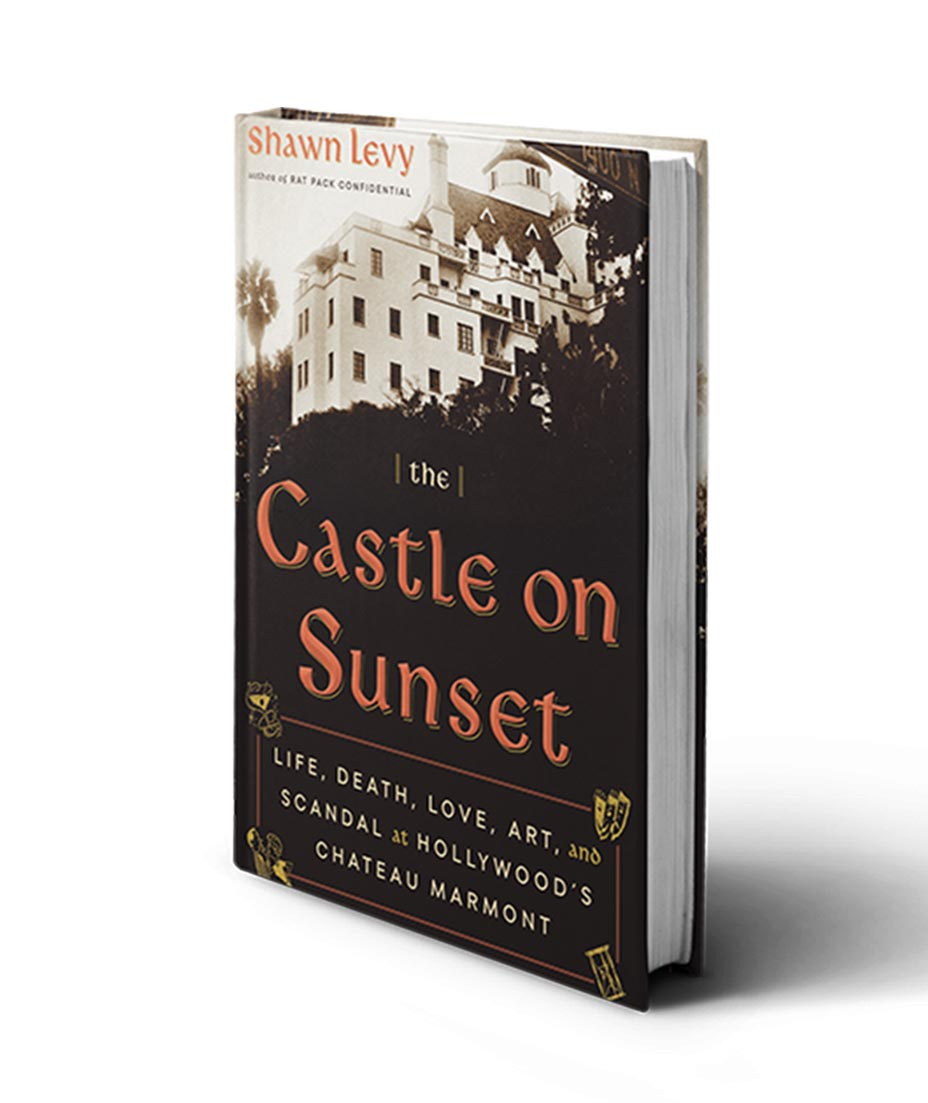 Book cover of The Castle on Sunset by Shawn Levy
Book cover of The Castle on Sunset by Shawn Levy
Shawn Levy’s “The Castle on Sunset” provides a detailed history of Chateau Marmont, including the significant event of John Belushi’s death.
From the book The Castle on Sunset by Shawn Levy. Copyright © 2019 Shawn Levy. To be published by Doubleday, an imprint of The Knopf Doubleday Publishing Group, a division of Penguin Random House LLC.
This story first appeared in the April 24 issue of The Hollywood Reporter magazine. To receive the magazine, click here to subscribe.
